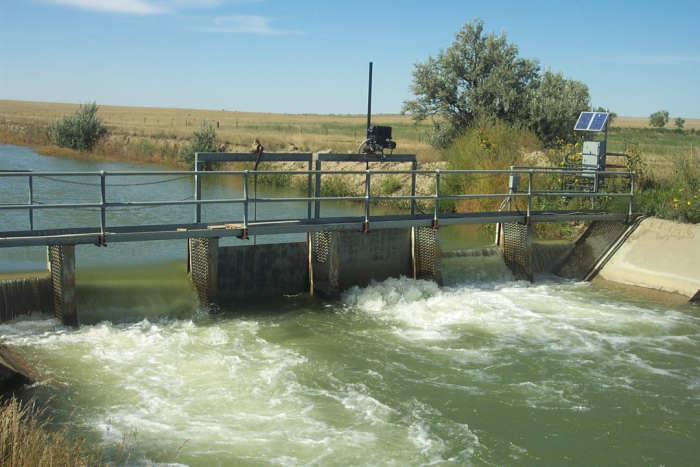




サウスダコタ州西部のブラックヒルズのすぐ北にある半乾燥地域には、農業に適した広大な台地が広がっています。この地域はさまざまなニーズがあるため、灌漑を注意深く監視する必要があります。ベル フーシェ川の北側の土地は、主に水分を保持する粘り気のあるガンボ土で構成されています。適切な排水が行われないと、余分な水が下層土に浸透し、塩分が表面に上がり、その地域は灌漑できなくなります。一方、ベル フーシェ川の南側の土地は水を多く必要とする砂質ローム土で、頻繁に水やりが必要です。
この地域の複雑な灌漑ニーズを認識し、開拓局はベル フォーシュ灌漑地区 (BFID) を設立しました。BFID は、94 マイルの幹線運河、450 マイルの開放側溝、および複数のダムを使用して、202 km 2 (50,000 エーカー) を超える耕作地に水を供給する灌漑システムの管理、運用、および保守を担当しています。
この地域は度重なる干ばつに見舞われているため、地域全体の灌漑ニーズを満たす十分な水供給を確保するには、節水が不可欠です。BFID は、運河の水位変動を減らし、水の損失を減らして供給効率を高めたいと考えていました。これを実現するには、BFID の運河チェック構造を自動化する必要がありました。
BFID は、プロジェクトの調整、設置、アドバイス、システム構成、およびトラブルシューティングを支援するため、統合コンサルティングおよびサービス会社である RESPEC と契約しました。2006 年、RESPEC は BFID 運河チェック構造の自動化を開始しました。RESPEC は、水位センサー、ゲート高さセンサー、およびゲート アクチュエータを Campbell Scientific データ ロガー (CR1000、CR850、および CR200X モデル) と組み合わせて設置しました。RESPEC は、過去 10 年間に BFID の自動化キャンペーンを複数回実施してきました。RESPEC は、2008 年に Intermountain Environmental (IEI) と提携し、現在の自動化サイトおよびリピーター ステーションの約半分を設置しました。RESPEC は、自動化システムの保守と更新を続けています。
自動チェック ゲートは、水路システム全体の上流の水位を一定に保ちます。水位の変動に応じて自動ゲートを上下に動かすことで、希望する水位が維持されます。その結果、水位が一定に保たれ、農家の分岐点や側方ヘッド ゲートへの水の供給がより効率的になります。特定のチェック構造の水位がゲートで制御できない範囲を超えた高さに達した場合、Campbell Scientific の LoggerNet ソフトウェアは、テキスト メッセージで灌漑担当者の携帯電話にアラーム通知を送信するように構成されています。
複数の自動ヘッド ゲートは、流量測定構造と組み合わせて機能します。LoggerNet を使用して、必要な横方向の流量をデータ ロガーにプログラムすると、横方向のヘッド ゲートは自動的に調整され、その流量が供給されます。流量は、Parshall フリューム、ロング スロート フリューム、または定水頭オリフィス構造を使用して、ゲートの上流または下流で測定されます。フリュームの水位センサーは、情報を Campbell Scientific データ ロガーに中継します。
RESPEC は、RF450 スペクトラム拡散無線を使用して、BFID 全体に及ぶ広範な無線通信ネットワークを構築し、調整しました。このネットワークにより、選択されたサイトは、サウスダコタ州ニューウェルの BFID 本部から、または車載型モバイル ベース ステーションを使用して BFID 内のどこからでもリアルタイムで監視および制御されます。
導入された自動ゲートによる利点を評価し定量化するために、RESPEC は、サウス運河の主要支線である Vale Lateral の分析を実施しました。チェック ゲートの自動化が導入される前の 2005 年には、上流の運河の水位は 1.0 フィートを超える変動を示していました。2006 年に Vale ゲートが自動化された後は、運河の水位は ±0.05 フィート以内の変動を示しました。給水記録に基づくと、チェック ゲートの自動化によって給水効率が 84% 向上しました。2007 年には、リアルタイム自動化ヘッド ゲートとセンサーが Vale Lateral 水路に設置されました。この設置により、プログラムされた正確な量の水が支線に無駄なく供給されるようになりました。推定損失削減量は年間 3,460 エーカー フィートで、灌漑システム全体に分配したり、貯水池でレクリエーション目的に使用したりするための水が増えます。
灌漑業者に送られない余剰水は、システムを通って運河の端から排水路を通って流れ出ます。この過程で、水は運河から堆積物を拾い上げ、灌漑地から流れを戻します。余剰水の量を減らすことで、堆積物の量も減ります。隣接するベル フーシェ川に排出される堆積物が減ることで、水質と漁業が改善されます。ベル フーシェ貯水池 (ベル フーシェ国立野生生物保護区とロッキー ポイント レクリエーション エリアの本拠地) でのレクリエーションの可能性も高まります。
2006 年以来、RESPEC は、さまざまな Campbell Scientific データ ロガーと広範な RF450 無線ネットワークを使用して、50 を超える運河チェック構造を自動化してきました。運河チェック構造のアップグレードにより、BFID は給水効率を改善し、地区の灌漑ニーズに引き続き対応し、毎年何千人もの訪問者のためのレクリエーション リソースを保護することができました。